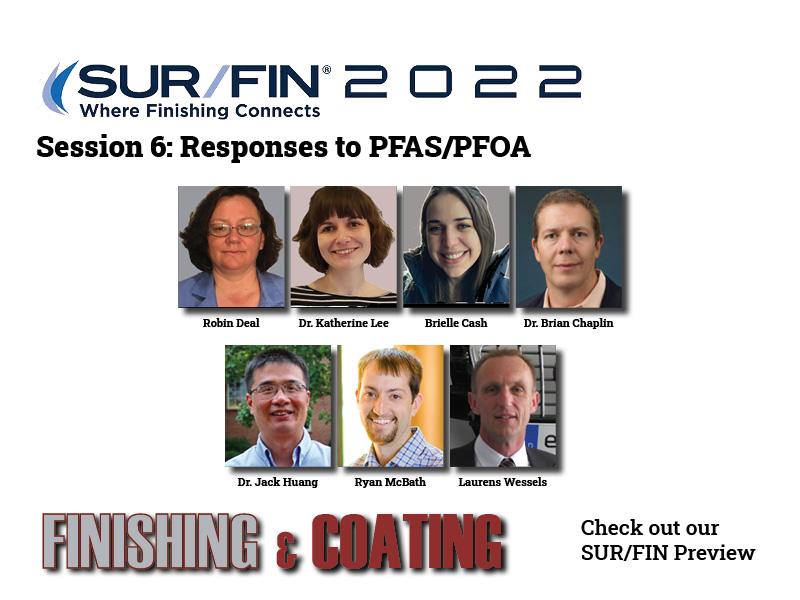Session 6 at the NASF SUR/FIN Technical Conference will be on “Responses to PFAS/PFOA.”
Here are the abstracts for the presentations on June 7. Please visit www.nasfsurfin.com for information on registering for the event:
Session 6: Responses to PFAS/PFOA
Session Chairs Fernando Carminholi, Hubbard-Hall, and Tim Hall, Faraday Technology
1:30 – 2:00: A Non-PFAS Conversion Case Study — Ryan McBath, Atotech USA
 Ryan McBathWith continued pressure to monitor and eliminate PFAS compounds from the Plating Industry, this presentation will outline a path forward for Plating on Plastic and Decorative Chrome applicators. This presentation will closely follow the case study of one facility’s conversion from PFAS containing wetting agents to non-PFAS equivalents, thereby eliminating all new additions of PFAS and moving forward with a smaller and more sustainable environmental footprint. The journey of conversion from PFAS containing wetting agents in both chromo-sulfuric etch and hexavalent decorative plating tanks can be complicated and winding due to deep rooted standard industry practices, as well as state and federal regulations. Outlined in this presentation is a clear and direct course of action that lead to this, and other, facilities eliminating PFAS from their wetting agent strategies. This plating facility is a large decorative plating on plastic company that supplies the automotive market. In less than one year this company has successfully navigated the conversion process and are fully converted to non-PFAS wetting agents in both the etch and decorative chrome tanks while maintaining their high quality, workplace and environmental standards. This roadmap and case study will allow other plating facilities in every EPA region a fast track to a future with non-PFAS wetting agents.
Ryan McBathWith continued pressure to monitor and eliminate PFAS compounds from the Plating Industry, this presentation will outline a path forward for Plating on Plastic and Decorative Chrome applicators. This presentation will closely follow the case study of one facility’s conversion from PFAS containing wetting agents to non-PFAS equivalents, thereby eliminating all new additions of PFAS and moving forward with a smaller and more sustainable environmental footprint. The journey of conversion from PFAS containing wetting agents in both chromo-sulfuric etch and hexavalent decorative plating tanks can be complicated and winding due to deep rooted standard industry practices, as well as state and federal regulations. Outlined in this presentation is a clear and direct course of action that lead to this, and other, facilities eliminating PFAS from their wetting agent strategies. This plating facility is a large decorative plating on plastic company that supplies the automotive market. In less than one year this company has successfully navigated the conversion process and are fully converted to non-PFAS wetting agents in both the etch and decorative chrome tanks while maintaining their high quality, workplace and environmental standards. This roadmap and case study will allow other plating facilities in every EPA region a fast track to a future with non-PFAS wetting agents.
2:00 – 2:30: Implementable Water and Waste Reduction Strategies — Brielle Cash, Loureiro Engineering Associates
 Brielle CashImproper wastewater management can lead to significant consequences for surface finishers. Excessive costs for off-site shipment, liability from regulatory requirements, and impacts to production can quickly burn a hole in a plater’s pocket. However, when waste minimization and wastewater management are coupled, regulatory risks are reduced and financial benefits are reaped. This presentation will first cover typical water management strategies easily implementable for surface finishers, including simple opportunities to add instrumentation or controls at wastewater-generating processes. Recommendations will be provided on how to trend data to predict complications before they occur, plus the benefits of identifying abnormal conditions proactively. Lastly, creative marriages of waste minimization and water management will be presented. One facility transformed an aging wastewater treatment system to reuse waste etching solution as treatment chemistry, adapting to keep up with production demand plus eliminating an additive cost. Another facility eliminated regulatory risk and continues to save 1.9 million gallons of water per year after implementing a zero liquid discharge wastewater treatment system.
Brielle CashImproper wastewater management can lead to significant consequences for surface finishers. Excessive costs for off-site shipment, liability from regulatory requirements, and impacts to production can quickly burn a hole in a plater’s pocket. However, when waste minimization and wastewater management are coupled, regulatory risks are reduced and financial benefits are reaped. This presentation will first cover typical water management strategies easily implementable for surface finishers, including simple opportunities to add instrumentation or controls at wastewater-generating processes. Recommendations will be provided on how to trend data to predict complications before they occur, plus the benefits of identifying abnormal conditions proactively. Lastly, creative marriages of waste minimization and water management will be presented. One facility transformed an aging wastewater treatment system to reuse waste etching solution as treatment chemistry, adapting to keep up with production demand plus eliminating an additive cost. Another facility eliminated regulatory risk and continues to save 1.9 million gallons of water per year after implementing a zero liquid discharge wastewater treatment system.
2:30 – 3:00: 7 Things I Wish I Knew About Wastewater Treatment —Robin Deal, Hubbard Hall
 Robin DealIf you plan on expanding your facilities production capabilities, or adding new processes to your product offerings, how can you ensure your wastewater system is adequate for the job of processing the increase of wastewater it will see? Do you include cost to treat the wastewater in pricing for your finished product? How do you calculate the cost of water in the manufacturing process? Your cleaner produces a lot of foam when it is dumped into wastewater. What issues does that cause? How can you prevent this? Other common concerns with wastewater treatment include chemical dosing, flocculation, and containment, to name a few. Join us as we look at some of these issues as they happened, how the situation was handled, and how things could have been prevented.
Robin DealIf you plan on expanding your facilities production capabilities, or adding new processes to your product offerings, how can you ensure your wastewater system is adequate for the job of processing the increase of wastewater it will see? Do you include cost to treat the wastewater in pricing for your finished product? How do you calculate the cost of water in the manufacturing process? Your cleaner produces a lot of foam when it is dumped into wastewater. What issues does that cause? How can you prevent this? Other common concerns with wastewater treatment include chemical dosing, flocculation, and containment, to name a few. Join us as we look at some of these issues as they happened, how the situation was handled, and how things could have been prevented.
3:00 – 3:30: Effects of Electroplating Wastewater Composition on the Electrochemical Destruction of PFAS Using a Reactive Electrochemical Membrane — Dr. Brian Chaplin, Univ. of Illinois at Chicago
 Dr. Brian ChaplinPer- and polyfluoroalkyl substances (PFASs) have been used in metal finishing and electroplating applications, due to their ability to act as a mist suppressant. These compounds are highly toxic and therefore require appropriate treatment. The overall objective of this work was to utilize a cost- effective reactive electrochemical membrane (REM) for the electrochemical destruction of PFASs from synthetic and real electroplating wastewater. Experimental work investigated the effect of potential and flow rate on PFAS oxidation with a Ti4O7 REM. It was determined that high electrode potentials (> 3.0 V/SHE) and low flow rates achieved significant conversion of PFAS in synthetic solutions, but conversion was significantly affected by constituents found in electroplating wastewater and resulted in increased energy usage. A preconcentration strategy of PFAS before electrochemical oxidation was investigated to overcome these challenges, and the results will be discussed in context of total PFAS conversion and energy consumption. Results from this work will also be discussed in terms of further development of this technology in the face of regulatory uncertainty of PFAS.
Dr. Brian ChaplinPer- and polyfluoroalkyl substances (PFASs) have been used in metal finishing and electroplating applications, due to their ability to act as a mist suppressant. These compounds are highly toxic and therefore require appropriate treatment. The overall objective of this work was to utilize a cost- effective reactive electrochemical membrane (REM) for the electrochemical destruction of PFASs from synthetic and real electroplating wastewater. Experimental work investigated the effect of potential and flow rate on PFAS oxidation with a Ti4O7 REM. It was determined that high electrode potentials (> 3.0 V/SHE) and low flow rates achieved significant conversion of PFAS in synthetic solutions, but conversion was significantly affected by constituents found in electroplating wastewater and resulted in increased energy usage. A preconcentration strategy of PFAS before electrochemical oxidation was investigated to overcome these challenges, and the results will be discussed in context of total PFAS conversion and energy consumption. Results from this work will also be discussed in terms of further development of this technology in the face of regulatory uncertainty of PFAS.
3:30 – 4:00: Electrochemical Remediation of PFAS-Contaminated Aqueous Waste Streams — Katherine Lee, Faraday Technology
 Dr. Katherine LeeThis talk will present recent progress toward development of an economical and energy-efficient processes to pretreat waste streams for removal of per-/polyfluorinated alkyl species (PFAS). PFAS have historically been used across a wide variety of applications, including carpeting, apparel, upholstery, metal plating and firefighting foams. However, research has demonstrated that these compounds are highly refractory and bio-accumulative when released to the environment, and have the potential to cause adverse health effects, such as low birth weight, accelerated puberty, cancer, and skeletal, liver, kidney and other problems. Thus, multiple regulatory agencies, including the U.S. and various state EPAs, are in the process of defining actionable maximum contaminant limits for numerous PFAS. Existing state-of-the-art treatment techniques such as sorption by activated carbon work to remove PFAS in certain circumstances, but are extremely costly, often cannot be used for waste streams with complex composition, and ultimately only postpone the disposal challenge as the PFAS-laden media itself becomes a waste stream requiring treatment. Thus, it is desirable to develop an energy and cost-efficient technology for degradation/destruction of PFAS in various industrial waste streams, landfill leachates, soil-derived streams, etc., to provide a final disposal/treatment solution. Faraday is working to demonstrate a pulsed-waveform electrocatalysis approach for PFAS destruction with clearly superior performance to direct-current methods, enhancing destruction of more-challenging short-chain PFAS and enabling PFAS destruction even in complex matrices. Cost analysis estimates indicate that the use of pulsed waveforms has the potential to provide appreciable reductions in OPEX, providing a combined preliminary CAPEX/OPEX cost structure that appears favorable for deployment of this technology for destruction of PFAS in various streams, including drinking water, electroplating rinse waters, landfill leachates and soil/groundwater.
Dr. Katherine LeeThis talk will present recent progress toward development of an economical and energy-efficient processes to pretreat waste streams for removal of per-/polyfluorinated alkyl species (PFAS). PFAS have historically been used across a wide variety of applications, including carpeting, apparel, upholstery, metal plating and firefighting foams. However, research has demonstrated that these compounds are highly refractory and bio-accumulative when released to the environment, and have the potential to cause adverse health effects, such as low birth weight, accelerated puberty, cancer, and skeletal, liver, kidney and other problems. Thus, multiple regulatory agencies, including the U.S. and various state EPAs, are in the process of defining actionable maximum contaminant limits for numerous PFAS. Existing state-of-the-art treatment techniques such as sorption by activated carbon work to remove PFAS in certain circumstances, but are extremely costly, often cannot be used for waste streams with complex composition, and ultimately only postpone the disposal challenge as the PFAS-laden media itself becomes a waste stream requiring treatment. Thus, it is desirable to develop an energy and cost-efficient technology for degradation/destruction of PFAS in various industrial waste streams, landfill leachates, soil-derived streams, etc., to provide a final disposal/treatment solution. Faraday is working to demonstrate a pulsed-waveform electrocatalysis approach for PFAS destruction with clearly superior performance to direct-current methods, enhancing destruction of more-challenging short-chain PFAS and enabling PFAS destruction even in complex matrices. Cost analysis estimates indicate that the use of pulsed waveforms has the potential to provide appreciable reductions in OPEX, providing a combined preliminary CAPEX/OPEX cost structure that appears favorable for deployment of this technology for destruction of PFAS in various streams, including drinking water, electroplating rinse waters, landfill leachates and soil/groundwater.
4:00 – 4:30: Treatment of Wastewater Containing Per- and Polyfluoroalkyl Substances By Foam Fractionation and Electrooxidation — Jack Huang, University of Georgia
 Dr. Jack HuangPer- and polyfluoroalkyl substances (PFASs) are a group of chemicals of unique properties and have been widely used in industry processes and consumer products, including electroplating. Studies suggest that exposure to high levels of certain PFAS may lead to adverse health effects. Accordingly, regulations and standards are evolving to address PFAS contamination. Perfluorooctanesulfonic acid (PFOS) was used for metal finishing and electroplating applications as mist suppressant, and it was later replaced by 6:2 fluorotelomer sulfonic acid (6:2 FTS). Given the health concerns and emerging regulations, it is in urgent need to develop technologies that can effectively treat PFAS-containing wastewaters. We in this study examined two promising technologies, foam fractionation (FF) and electrooxidation (EO). FF is effective to separate PFASs from wastewater, forming a low-volume and high-concentration PFAS solution. EO using Magnéli phase titanium sub-oxide anode is effective to destruct PFAS in wastewater or in the concentrated waste generated by FF. The results suggest that FF and EO can be used for treatment of PFAS-containing electroplating wastewater, individually or in combination, depending on situations and treatment goals.
Dr. Jack HuangPer- and polyfluoroalkyl substances (PFASs) are a group of chemicals of unique properties and have been widely used in industry processes and consumer products, including electroplating. Studies suggest that exposure to high levels of certain PFAS may lead to adverse health effects. Accordingly, regulations and standards are evolving to address PFAS contamination. Perfluorooctanesulfonic acid (PFOS) was used for metal finishing and electroplating applications as mist suppressant, and it was later replaced by 6:2 fluorotelomer sulfonic acid (6:2 FTS). Given the health concerns and emerging regulations, it is in urgent need to develop technologies that can effectively treat PFAS-containing wastewaters. We in this study examined two promising technologies, foam fractionation (FF) and electrooxidation (EO). FF is effective to separate PFASs from wastewater, forming a low-volume and high-concentration PFAS solution. EO using Magnéli phase titanium sub-oxide anode is effective to destruct PFAS in wastewater or in the concentrated waste generated by FF. The results suggest that FF and EO can be used for treatment of PFAS-containing electroplating wastewater, individually or in combination, depending on situations and treatment goals.
4:30 – 5:00: Advanced Waste Treatments for Alkaline and Acid Zinc-Nickel Waste — Laurens Wessels, MacDermid Envio Solutions
 Laurens WesselsThe presentation Advanced Waste Treatments for Alkaline and Acid Zinc-Nickel Waste will outline an innovative new approach to treating both rinse waters and concentrated wastes for Alkaline and Acid Zinc-Nickel processes. Considering the increasing demand for High Performance Zinc-Nickel high anti- corrosion coatings, treating the respective waste is becoming more and more important. As Zinc-Nickel electroplating chemistry can be more challenging to waste treat than standard alkaline or acid-based zinc electroplating processes, new and innovative approaches to treating the respective wastewater can make life easier for the Surface Finishing industry. With the continued success and increasing demand for High Performance Zinc-Nickel high anti- corrosion coatings, the surface finishing industry has been instrumental in extending the life of many components fabricated from Steel. However, Zinc-Nickel electroplating chemistry can be more challenging to waste treat than standard alkaline or acid-based zinc electroplating processes. This presentation will explain the reasons behind these challenges and outline an innovative new approach to treating both rinse waters and concentrated wastes for Alkaline and Acid Zinc-Nickel process.
Laurens WesselsThe presentation Advanced Waste Treatments for Alkaline and Acid Zinc-Nickel Waste will outline an innovative new approach to treating both rinse waters and concentrated wastes for Alkaline and Acid Zinc-Nickel processes. Considering the increasing demand for High Performance Zinc-Nickel high anti- corrosion coatings, treating the respective waste is becoming more and more important. As Zinc-Nickel electroplating chemistry can be more challenging to waste treat than standard alkaline or acid-based zinc electroplating processes, new and innovative approaches to treating the respective wastewater can make life easier for the Surface Finishing industry. With the continued success and increasing demand for High Performance Zinc-Nickel high anti- corrosion coatings, the surface finishing industry has been instrumental in extending the life of many components fabricated from Steel. However, Zinc-Nickel electroplating chemistry can be more challenging to waste treat than standard alkaline or acid-based zinc electroplating processes. This presentation will explain the reasons behind these challenges and outline an innovative new approach to treating both rinse waters and concentrated wastes for Alkaline and Acid Zinc-Nickel process.



































